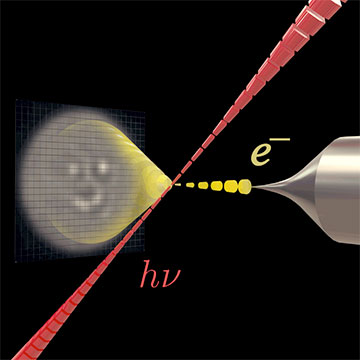
Experiments carried out at the University of Vienna show that intense pulses of laser light (red) can transform the profile of electron beams (yellow) into arbitrary shapes, such as the smiley face seen here. [Image: stefaneder.at, University of Vienna]
Researchers in Austria and Germany have shown how to mold the profile of an electron beam using short, intense pulses of laser light. They say that their scheme, which they implement by modifying a scanning electron microscope, could enhance the resolution of electron microscopy by better correcting aberrations (Phys. Rev. X, doi: 10.1103/PhysRevX.12.031043).
Shaping wavefronts
Ground-based astronomy, deep-tissue imaging and other applications involving visible light have in recent years benefited from the technique of adaptive optics. This involves using deformable mirrors to modify the wavefront of light to precisely compensate for distortions caused by turbulence or the presence of dense materials—thereby boosting image resolution.
Scientists have also shown how to modify the wavefronts of electron beams, which have very short wavelengths and can therefore be used to create images not possible with visible light. Demonstrations have involved sending electrons through patterned thin films and using nanofabrication to tune electric and magnetostatic potentials, as well as shaping electron beams via the fields of attosecond laser pulses. All approaches to date, however, have eroded beam quality—unwanted diffraction or inelastic scattering being two of the numerous side effects.
Phase modulations
The latest work, carried out by researchers at the University of Vienna, Austria, and the University of Siegen, Germany, relies on a phenomenon known as the ponderomotive force. First postulated back in the 1930s, this interaction involves an inhomogeneous oscillating electromagnetic field modifying an electron’s phase—and thereby motion. But its exploitation requires carefully integrating electron optics with the necessary high-intensity laser light.
The University of Vienna’s Thomas Juffmann and colleagues do this using a modified ultrafast scanning electron microscope and a laser source producing femtosecond-length infrared pulses. They split the pulses in two and send the less intense part to generate a burst of electrons from a metal tip via the light’s fourth harmonic. They then use the remainder of each pulse to create the ponderomotive force, the strength of which—and hence the effect upon the electrons—they varied by shaping the light intensity distribution using a spatial light modulator.
With the electron and laser beams coming together head on, along a plane inside a vacuum chamber, the variations in light intensity translated into modulations of the phase across the electron wavefront. The size of those modulations—the “pixel” size—was 4.3 µm. Given the energy needed to shape a pixel and the total energy in each laser pulse, the researchers say they could, in principle, generate 1,600 pixels.
Put on a smiley face
Juffmann and co-workers showed that this process of beam shaping could yield both convex and concave electron lenses—the former imposing a phase shift that decreases quadratically across the beam axis while the latter causes a quadratic increase. They point out that this ability stands in contrast to that of conventional symmetric electron optics, which produce only convex lenses.
What’s more, the researchers demonstrated that they were able to program the process to generate essentially any arbitrarily shaped beam. They used the technique of back propagation to work out the phase variations needed in the spatial light modulator to yield several distinctive beam shapes, such as astigmatism as well as what are known as trefoil and coma. They also used 20 iterations of the more sophisticated Gerchberg–Saxton algorithm to produce a shape that resembles the smiley face ubiquitous in social media.
The researchers say that their work “paves the way to lossless electron wavefront shaping with hundreds of individually addressable pixels.” In particular, they reckon that the new scheme could be used to correct arbitrary aberrations in pulsed electron microscopes—potentially allowing greater resolution without scattering, sub-aperture diffraction and loss. However, they add that further studies are needed to establish whether the necessary components can be accommodated within such microscopes, given their limited space compared with scanning devices.
